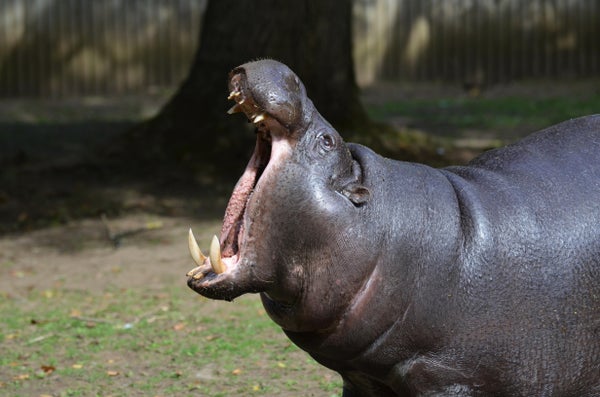Ever idly wondered if a capybara could somehow take down an elephant in a beachfront brawl? That’s the kind of thinking behind March Mammal Madness (MMM), an annual social media event based on the March Madness NCAA Men’s College Basketball Tournament. Like its namesake, this educational project encourages viewers to fill out brackets predicting which teams would triumph in a hypothetical head-to-head showdown—with the “teams” in this version being specific mammals. The virtual fights, each set in a randomly chosen arena, unfold as Twitter threads posted by participating scientists—with each move backed up by very real research, planning and pedagogy. As an approach to science education, the project is paying off: A new paper put together by the nearly 40 co-organizers suggests that hundreds of thousands of students, in addition to younger and older participants, have participated in MMM since its creation.
March Mammal Madness combines biological facts with a running narrative of fictional action that encourages those following along at home to hit “reload” as the Twitter thread updates. “All of that drama, those emotions—this is what makes MMM a shared experience that facilitates long-term retention of information,” says the paper’s lead author Katie Hinde, the event’s creator and an associate professor at Arizona State University’s Center for Evolution and Medicine. “For example, in 2019 moose was battling tiger in the Elite Trait [the round featuring the final eight competitors], and we waited until that battle to remind everyone that moose drop their antlers in the fall. Moose fans were shook,” she explains, as they realized that their chosen fighter would lose one of its key advantages against its feline foe. Then her team reminded them of the fact that a moose would never have used antlers against a tiger in the first place, because it employs its headgear in competition against other males, not as a defense against predators. “This is part of the roller-coaster ride of a battle narration,” Hinde says. Other past confrontations have involved pygmy hippo versus coyote, manatee against tapir, and one epic bout between short-faced bear and honey badger.
The project’s efforts at engaging narratives are based on educational theory. “Humans are psychologically and cognitively adapted for fireside storytelling, shared experiences, artistic imagery and jokey-joke-joke-jokes,” Hinde says. She believes that adding drama to science communication helps lessons stick. “Too many scientists ignore the evidence and continue to talk facts and probabilities in a vacuum,” she says. “Folks remember the science that ended their pick’s hunt for the MMM championship. There are people who can now tell you that platypus venom is seasonal, who would never pick up Philosophical Transactions of the Royal Society of London, Series B to read ‘Grant & Temple–Smith 1998.’”
On supporting science journalism
If you're enjoying this article, consider supporting our award-winning journalism by subscribing. By purchasing a subscription you are helping to ensure the future of impactful stories about the discoveries and ideas shaping our world today.
Though MMM players might not read the scientific literature, the co-organizers do—and they take in a lot of it, citing over 1,000 scholarly works that justify the behavior and biology on display in their virtual fights. “It’s evident that the folks writing the battles put their heart and soul into this project,” says Sarah McAnulty, the executive director of a virtual science education nonprofit called Skype a Scientist, who is not involved with MMM but follows the event. “I’ve learned about all kinds of animals and adaptations, and the process of researching the animals to pick who you think will win is a great and fun way for kids to dig into the science. It’s a super engaging way to learn animal facts.”
Many teachers agree, and have encouraged their students to join in. The new paper estimates that about 1 percent of all high school students in the U.S. participate—a relatively large audience for a science communication initiative. “Even though it’s simulated, I love that it takes all of these biology concepts we’re learning and makes them real and cohesive and applicable,” says Linda Correll, the science supervisor for Fauquier County, Va., public schools. “All of a sudden understanding biomes, symbiotic relationships, and adaptations gives you an edge in trying to answer the question of who is going to win.” In addition to creating the contest, the MMM team provides free educational resources to help students with their research. “The narratives are exciting and educational, and I love when my students get upset that [an] unstoppable apex predator loses to something they find helpless or weak,” Correll says. “These are great teachable moments.”
March Mammal Madness has formal partnerships with science teachers around the country—and also reaches adults who have outgrown traditional science classes. “To see so much engagement with the content we create is really exciting,” says Eduardo Amorim of the University of Lausanne, a co-organizer and co-author. “Families play together at home. Adults, teenagers and kids, scientists and nonscientists—I never imagined this would be something that reached so many people.”
Hinde is thrilled by how much March Mammal Madness has grown since she started it on her own in 2013. (Although the event is not directly affiliated with Arizona State University, and the current co-organizers come from a variety of institutions, ASU’s digital library still hosts MMM’s educational resources.) “I love this community brought together by our shared delight in the natural world,” she says. “Also, I love the trash talk. But really, the community, even in pandemic times, has been a refuge from despair.”
[Editor’s Note: The writer works part-time at a remote ASU-administered research center that has no relationship with the MMM program.]
The March Mammal Madness bracket will be released on February 26. Anyone wishing to participate can predict a winner for each listed match, then wait for the action to unfold on Twitter at preannounced times.
